BandRich C505 LTE USB Modem User Manual C505 UM 20111128 for lab
BandRich Inc. LTE USB Modem C505 UM 20111128 for lab
BandRich >
User manual

The
BandLuxe
C505
LTE USB Modem
User
Manual
PN: 65006900011
Contents
Chapter 1 Getting Started 3
Chapter 2 Connecting 8
Chapter 3 SMS 11
Chapter 4 Setting 13
Chapter 5 Statistics & Information 16
Chapter 6 Q&A 18
Chapter 7 Important Safety Information and
Glossary 21

The BandLuxe C505
Chapter 1
Getting Started

4
C
ha
p
ter 1 Getting Started
What’s content
BandLuxe C505 USB dongle modem
Features
● Support 3.5G, HSPA+ and LTE standard
( LTE/HSPA+/HSPA / WCDMA EDGEGPRS)
● Support SMS Message
● USB Interface
● Support microSD/microSDHC storage
● Support systems: Windows 7, Windows Vista,
Windows XP,
● Does not interfere with other USB
peripherals
● Multi language interface (English, French,
German, Italian, Spanish, Traditional
Chinese, Russian, Portuguese and Finnish)
● Plug & Play
Before You Install
Information
Before installing the C505, we recommend obtaining the following
information from the SIM Card Mobile network operator:
Access Point Name (APN)
- For many carriers, the APN may simply be Internet.
Phone Number
- The Phone Number to dial to establish a network connection.
BandLuxe software helps input this number correctly.
Password (Optional)
- Some (but not many) carriers require a password.
Notice: BandLuxe C505 is a radio device.
Please be aware to keep metal materials
away from the device.
Insert the SIM Card & microSD Memory Card
1. USB connector can be extended by shifting the left-side switch
(fig. 1)
2. Remove the front cover.(fig. 2)
3. Follow the arrow direction insert the SIM card(fig. 3)
4. micro SD card reader is equipped. Golden color contact of
microSD card should be faced up to insert. (fig. 4).
*micro SD card is an optional purchased accessory.
5. Replace the front cover
Hardware Installation
With the SIM card properly inserted, the C505 may now be installed
into the computer via USB port.
1. Insert the C505 into the computer.
2. The LED should light up when connection is established, though it
may be obscured.
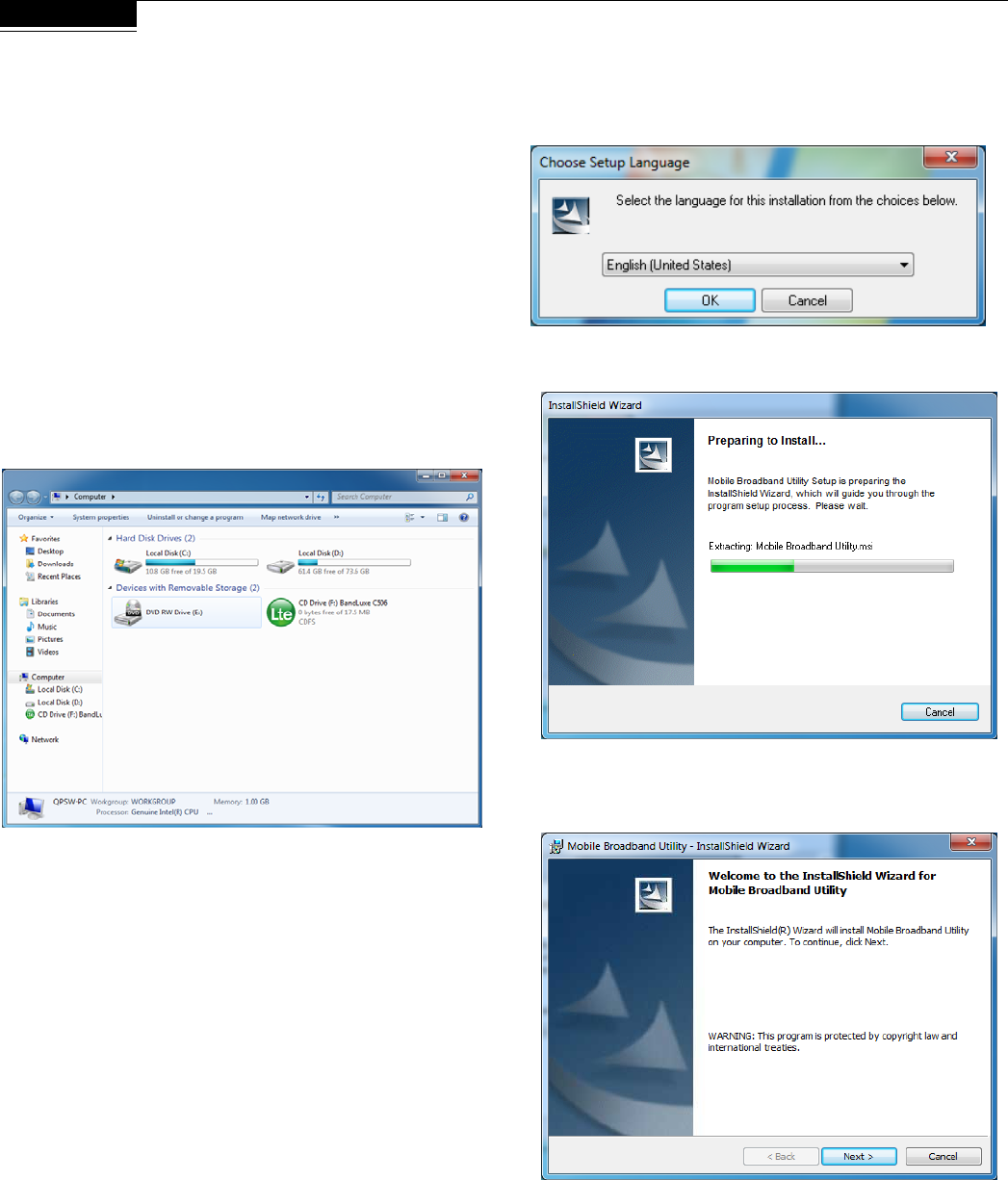
5
C
ha
p
ter 1 Getting Started
Software Installation
The process and appearance of certain software elements in Windows
Vista will be somewhat different than in XP. These differences are
minor and should not limit the functionality of the C505 in any way.
New Hardware Detection
Windows XP
Once the C505 is connected, a dialog box should pop up from the
Toolbar Hardware Connection Icon. The device will be identified as the
BandLuxe C505 LTE Utility.
Windows Vista / Windows7
In Vista, a pop-up window may appear. Click Allow to proceed.
After the first pop-up, all other aspects for software installation will be
identical in all compatible versions of Windows.
Software installation should proceed automatically. If it does not, it may
be initiated from My Computer, where the C505 will be identified as a
CD-ROM device. Sometimes a restart will occur during installation. If it
does, reinitiate installation from My Computer.
Install Shield Wizard
Setup Language
Preparation
The C505 will automatically use the appropriate language for your OS,
if available.
Welcome
The Setup Wizard window opens automatically. The first page contains
OS compatibility and legal disclaimers. Click Next to continue.

6
C
ha
p
ter 1 Getting Started
License Agreement
Click I accept the terms in the license agreement > Next to
continue.
Select Installation Folder
Click Change to manually select a folder.
Change Current Destination Folder
Highlight the folder and click OK to select it. Click Cancel to close the
Browse window.
Confirm Installation
Click Back to change any preceding information or settings. Click
Install to begin installation.
Installation
Installation time will depend on variable computer.
Installation Complete
When installation is completed, click Finish to exit. The Connection
Manager will open automatically

7
C
ha
p
ter 1 Getting Started
.Home Screen
1. Signal Strength
2. Minimize
3. Radio Technology
4. Mobile Network Operator
5. Connection Status
6. Connection Time Elapse
7. Total Data Uploaded
8. Total Data Downloaded
9. Menu
10. Home Screen
11. Connect/Disconnect
12. Close
Note: The Home screen only indicates LTE (internet) connection
status. After installation, the C505 automatically initiates SMS
functions upon successful connection to the computer. Text messages
can be sent or received, even if the Home screen indicates no
connection.
Menu Screen
SMS: Text message folders such as Inbox, Draft, etc.
Setting: General, SMS, SIM, Radio and Network preferences.
Statistics: Upload/Download graphs, totals and connection log.
Contacts: C505 SIM Card and Outlook Contact lists.
Profile: Connection profile setup/options.
Information: Device, Version and
1212
3
4
5
6
7
11
10
8
9

The BandLuxe C505
Chapter 2
Connecting
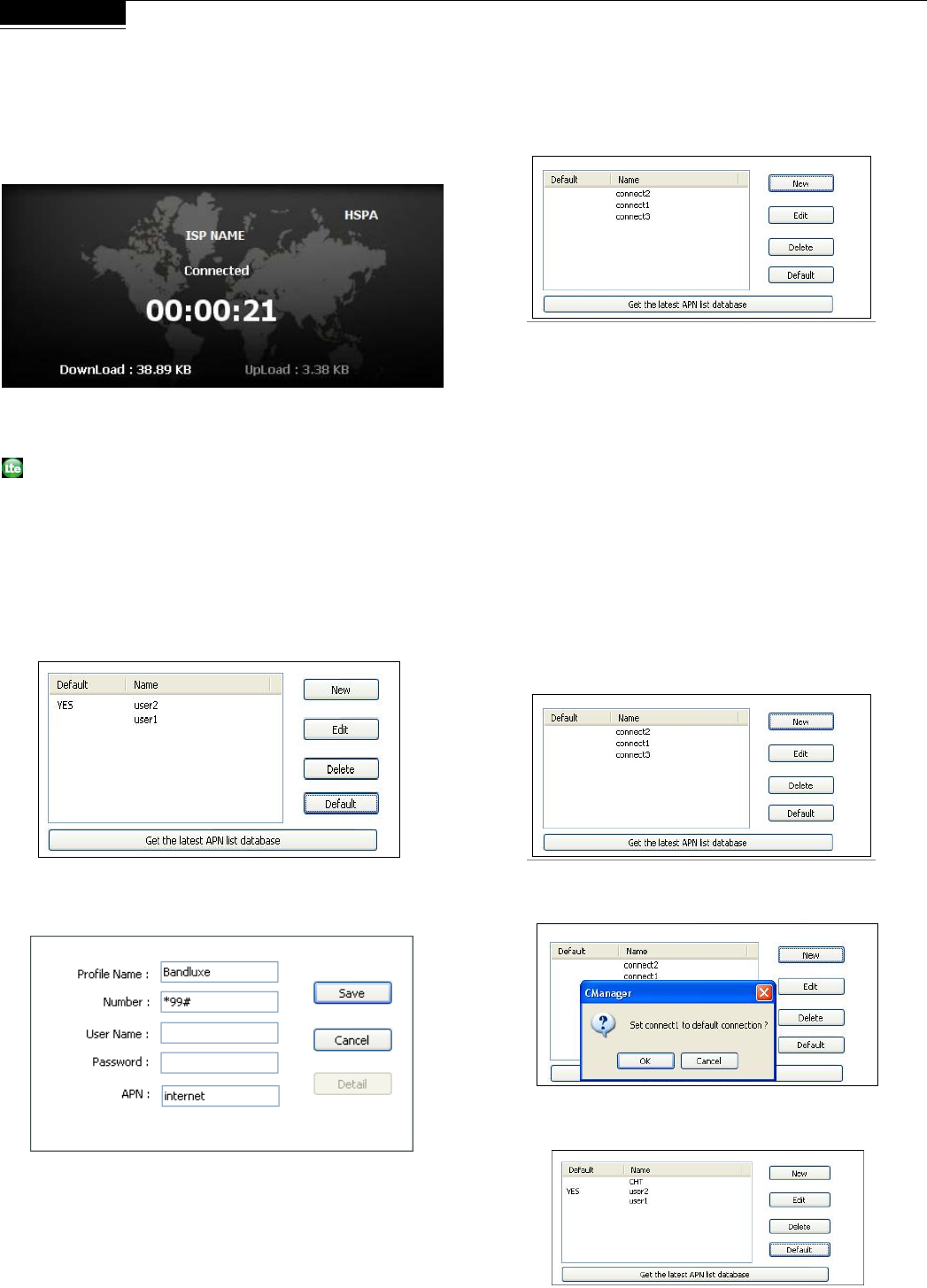
9
C
ha
p
ter 2 Connecting
Establishing a Connection
With the C505 installed, an online connection can be ready to use. The
C505 will automatically scan your system and create a default profile,
which should work in the vast majority of cases. To test it, simply click
the Connect button.
Connection should take about 5 seconds. When established, the
Home screen should show Connected, with the onscreen clock
running and the Download/Upload tallies running. The toolbar icon
will also change color to indicate the connection protocol (same
as LED indicator). See Specifications for details.
If connection is unsuccessful, check if the device and SIM card are
properly connected and inserted. If they are, a new internet profile may
need to be created.
Create a Profile
1. Click Menu > Profile. The profile menu will contain the default
profile, showing the operator's name of the SIM card.
2. Click New to create a new profile. Depending on the carrier, all 5
spaces may not need to be filled to proceed.
3. Choose a Profile Name. The name is arbitrary and is helpful when
different connection methods are available.
4. Inquire with the Mobile network operator (SIM carrier) as to whether
the User Name and Password are required.
5. The Password can be any combination of letters, numbers or
symbols and is case sensitive.
6. Enter the Access Point Name (APN) supplied by the SIM card
carrier.
7. Enter the phone number for establishing the wireless connection,
supplied by the SIM card carrier; click Save.
8. On the Profile window, click the newly created profile and then click
Default. Click OK to set this profile as the default (only the default
can be connected).
9. The BandLuxe C505 is now ready for a wireless connection. Click
the Connect icon to establish. Connection should take about 5
seconds. When established, the Home screen should show
Connected, with the onscreen clock running and the Download/
Upload tallies counting.
Note: If you switch to a different SIM card, the default profile will no
longer be valid. You will have to create a new profile in the
manner just described. If you can not access to all the
information necessary to create a new profile, just uninstall and
reinstall the BandLuxe software. The new default profile should
work for the new SIM card
Choose a Profile
Different profiles may be needed, depending on changeable location.
1. Click Menu > Profile.
2. Highlight the desired profile and click Default.
3. Click OK on the confirmation window if this is the desired profile.
4. The word YES will appear next to the default profile.
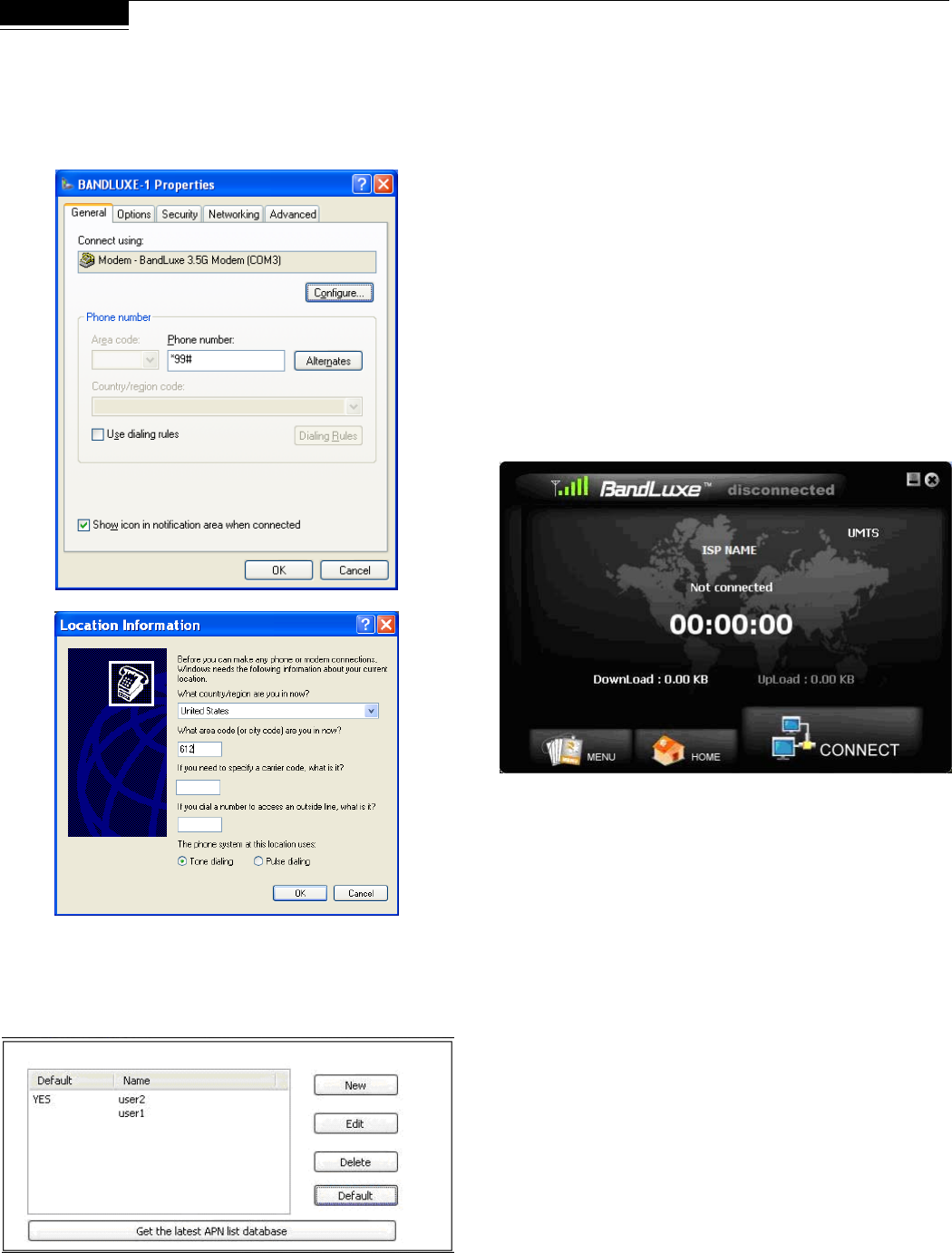
10
C
ha
p
ter 2 Connecting
Profile Properties
In the Profile window, click Edit to adjust the default profile. To adjust a
non-default profile, highlight it and then click Edit. Click Detail on the
Edit window to view the Properties menu, General Tab.
Get the latest APN List Database
The Profile provides the APN List Update function. When the network
connection is established, the APN List will be updated after clicking
this button.
General
Connect using
If other modems are available, they will be listed here. Click Configure
to adjust the BandLuxe modem settings.
Phone number
Check Use dialing rules to access the Location Information window to
add more specific dialing information such as tone/pulse dialing,
current region, area & carrier code, and outside line access
number.
Click OK when completed.
This and other Properties menu tabs are generic to the Windows OS
and will not be discussed further.
Connecting & Disconnecting
If a default profile has been selected, a connection can be made or
ended at any time by clicking the Connect button on the Menu screen.
However, connection status will not be obvious unless the Home
screen is displayed. The Statistics or Signal Information windows also
clearly display connection status.

The BandLuxe C505
Chapter 3
SMS
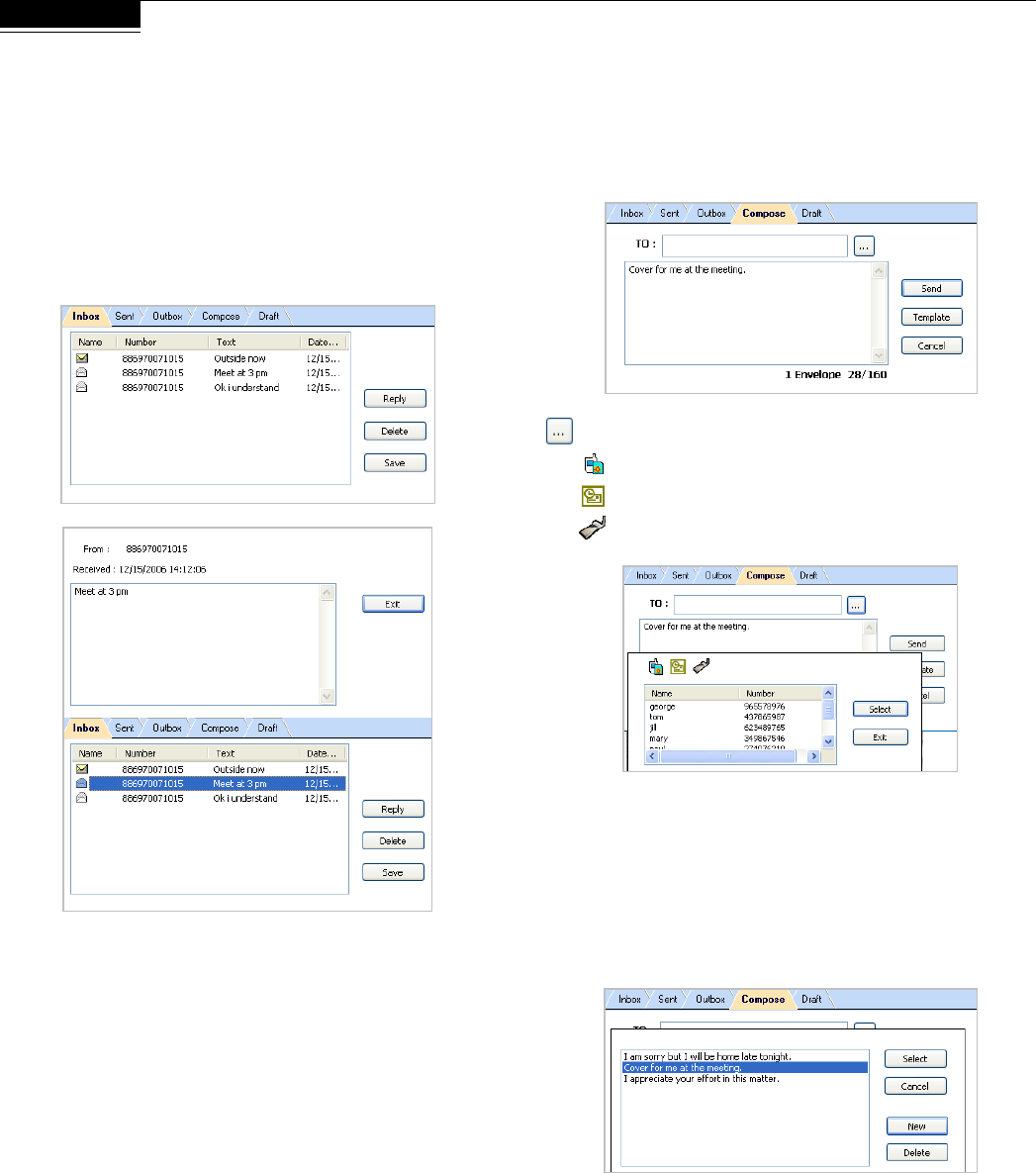
12
C
ha
p
ter
3
SMS
The Connection Manager allows the standard SMS options as any
other mobile devices. The related information, including Contact’s
name, number, body text and the stored date of each message in the
Inbox, Outbox, Sent and Draft folders will be displayed..
Inbox
It contains received messages. Save, Delete or Reply to Inbox
messages by highlighting them and pressing the appropriate button.
Highlight a message to make it scroll open above. Unread messages
are closed envelopes while read messages are opened.
Sent
It contains all successfully sent messages. Highlight a message and
press Delete to erase it.
Outbox
It contains completed but unsent messages. Send or Delete messages
by highlighting them and pressing the appropriate button.
Compose
It contains all tools for creating messages.
To: Contains the Phone Number of the recipient.
Message Body: Key in the content.
Press to see contact lists.
- SIM Card Contacts
- Outlook Contacts
- C505 Contacts
Highlight a Contact and click Select to choose it. Click Exit to return to
the Compose screen.
Click Template to view all stored templates, or create/delete one.
Highlight a template and click Select to insert it into the message.
Click New to create a new template. Click Save to add the new
template to the list of existing ones. Click Cancel to return to the
Template list window.
Highlight a template and click Delete to erase it.
Draft
It contains saved but unfinished messages. Highlight a draft and click
Edit to send the message back to the Compose window.

The BandLuxe C505
Chapter 4
Setting
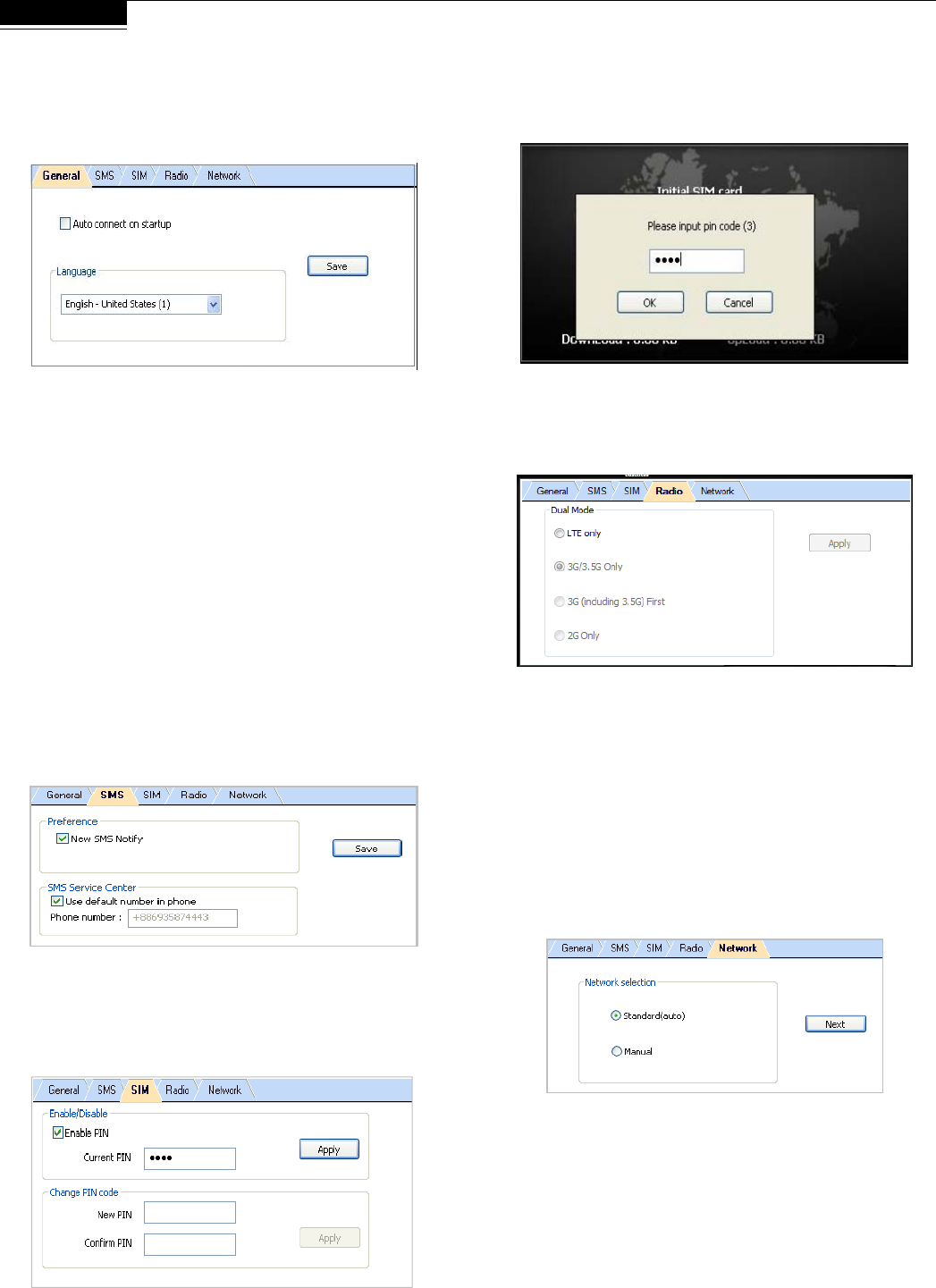
14
C
ha
p
ter 4 Setting
General
Check Auto connect on startup to have the C505 connect to the
internet automatically during startup.
Language
The Connection Manager offers multi languages interface. To choose
a language, click the menu to highlight and select a language. Click
Save to implement the chosen language. The Connection Manager
will then return to the Home Screen with the chosen language.
SMS
Preference
New SMS Notify: Check to be notified when a new text message
arrives. If enabled, the Toolbar Connection Manager Icon will change
to an Envelope Icon. An envelope icon will also appear in the upper left
corner of the Home screen when a new message arrives.
SMS Service Center
Use default number in phone: Uncheck to manually input service
center number.
Click Save after making any changes.
SIM
Enable/Disable or change the SIM card Personal Identification
Number (PIN). Press Apply after making any changes. A SIM card
must be inserted for this function to be activated.
If a PIN code is enabled, it will be asked during SIM card initialization.
After 3 incorrect PIN code entries, the SIM card will be locked. Contact
your operator to unlock it.
Radio
Dual Mode- Features various network search options. Note that LTE
only is the default setting.
After making changes to either, click Apply.
Notice: data transferring will be disconnected when
you apply new “Radio” setting.
Network
Network Selection
Standard (auto) Search for networks in the order specified in the
Prefer list. Click Standard (auto) > Next to view and adjust the Prefer
list.
The top list is the Prefer list; the bottom lists all available networks.
Click Scan to bring up the list of all available networks.
In the Prefer list, highlight a network and click the up arrow to the left to
move it up the list (increase its preference); clicking the down arrow
does the opposite. Clicking the red icon removes the highlighted
network from the Prefer list.
In the bottom list, highlight a network and click the up arrow above to
move that network to the Prefer list.
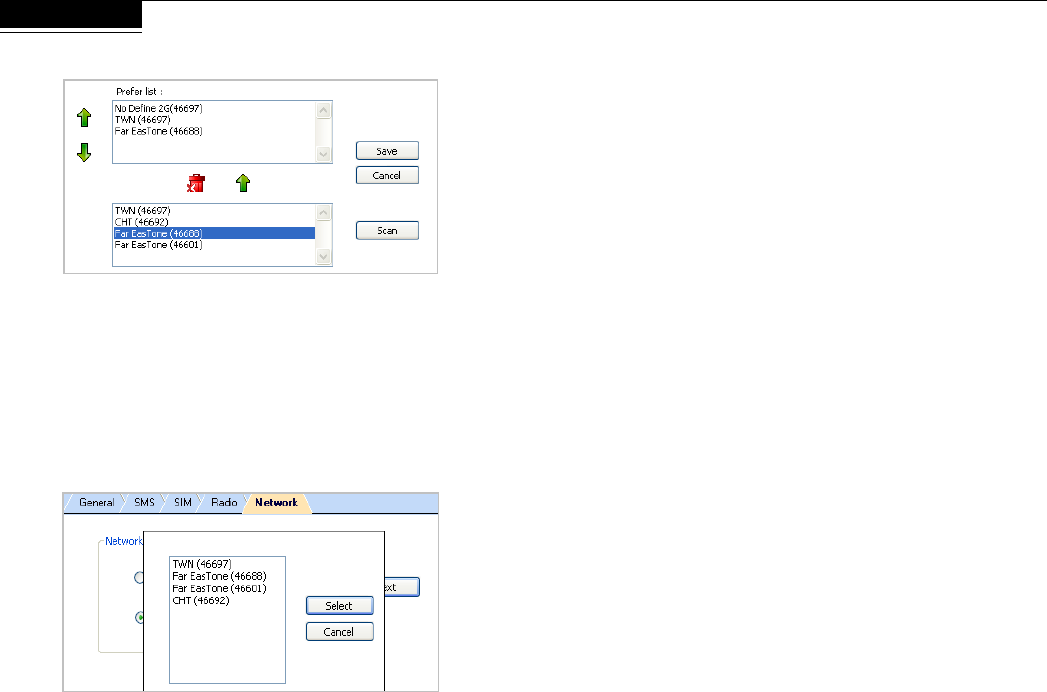
15
C
ha
p
ter 4 Setting
If changes are made, click Save.
Manual
Choose a network from all the available. Click Manual > Next to see
the list. Highlight a network and click Select. If no change is needed,
click Cancel.
Note that Network can only be accessed when the C505 is not
connected to a network.

The BandLuxe C505
Chapter 5
Statistics & Information
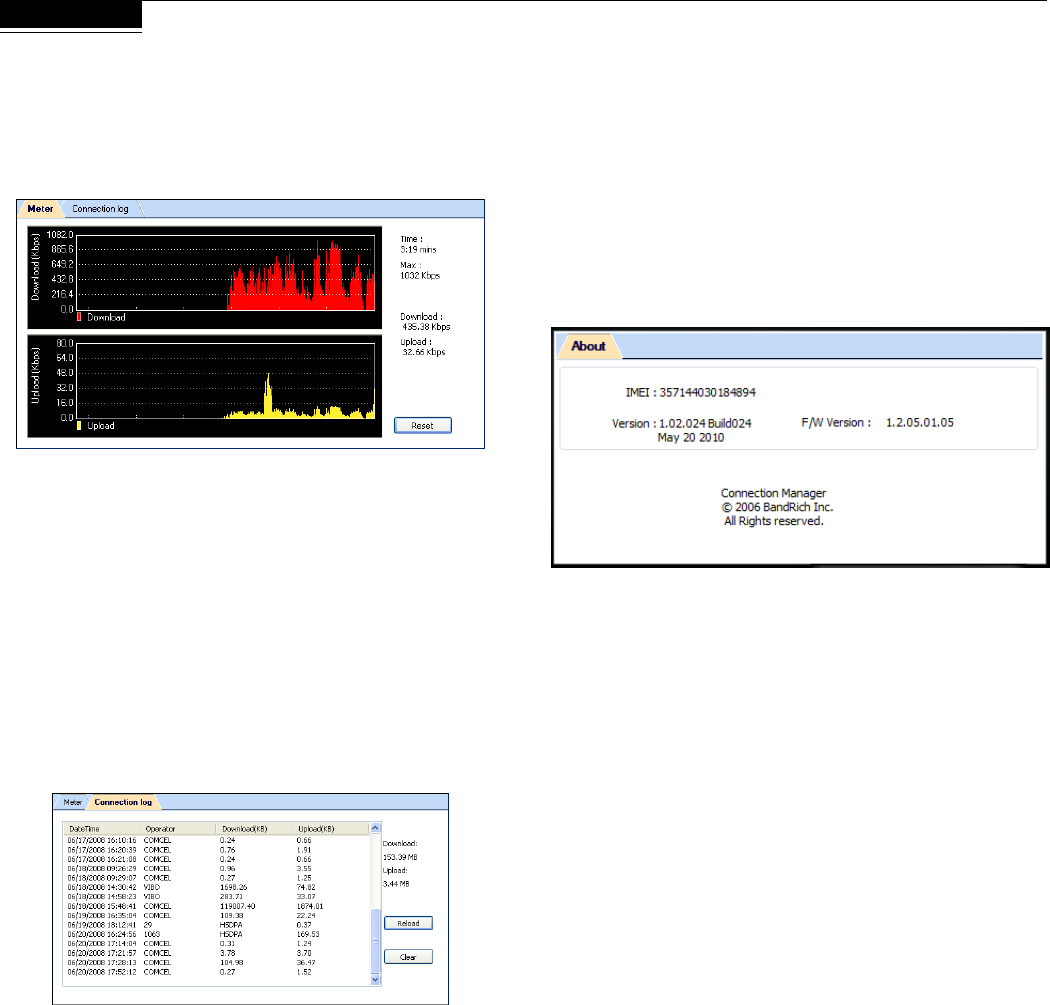
17
C
ha
p
ter
5
Statistics & Information
Statistics
The Statistics screen displays a graph of recent upload and download
activities. If there is no data shown, the C505 is disconnected. Click
Menu > Statistics.
Time: Elapsed Connection Time
- Returns to zero upon disconnection
- Reset does not affect it
Max: Maximum Throughput
Download: Current Downloading Throughput
Upload: Current Uploading Throughput
Click Reset to end the current graphs and start over. This will not affect
the actual connection.
Connection log
Click Menu > Statistics > Connection log to see data counting by
each connection status and accumulated connection status
Each data counting
- DateTime: The date and time of connection log
- Operator: Telecom network operator
- Download(KB): Downloaded Throughput
- Upload(KB): Uploaded Throughput
Accumulated data counting
- Download: Total Downloaded Throughput
- Upload: Total Uploaded Throughput
Click Reload to reload the latest data information. Click Clear to
clear all data counting information
* The data counting here is only for reference, please check
operator for real data throughput if any.
Information
The Information screen offers version or signal specifications. Click
Menu > Information.
About
Click Menu > Information > About tab to see version data.
IMEI: International Mobile Equipment Identity number
Version: Connection Manager Software Version
F/W Version: Firmware Version

The BandLuxe C505
Chapter 6
Q&A
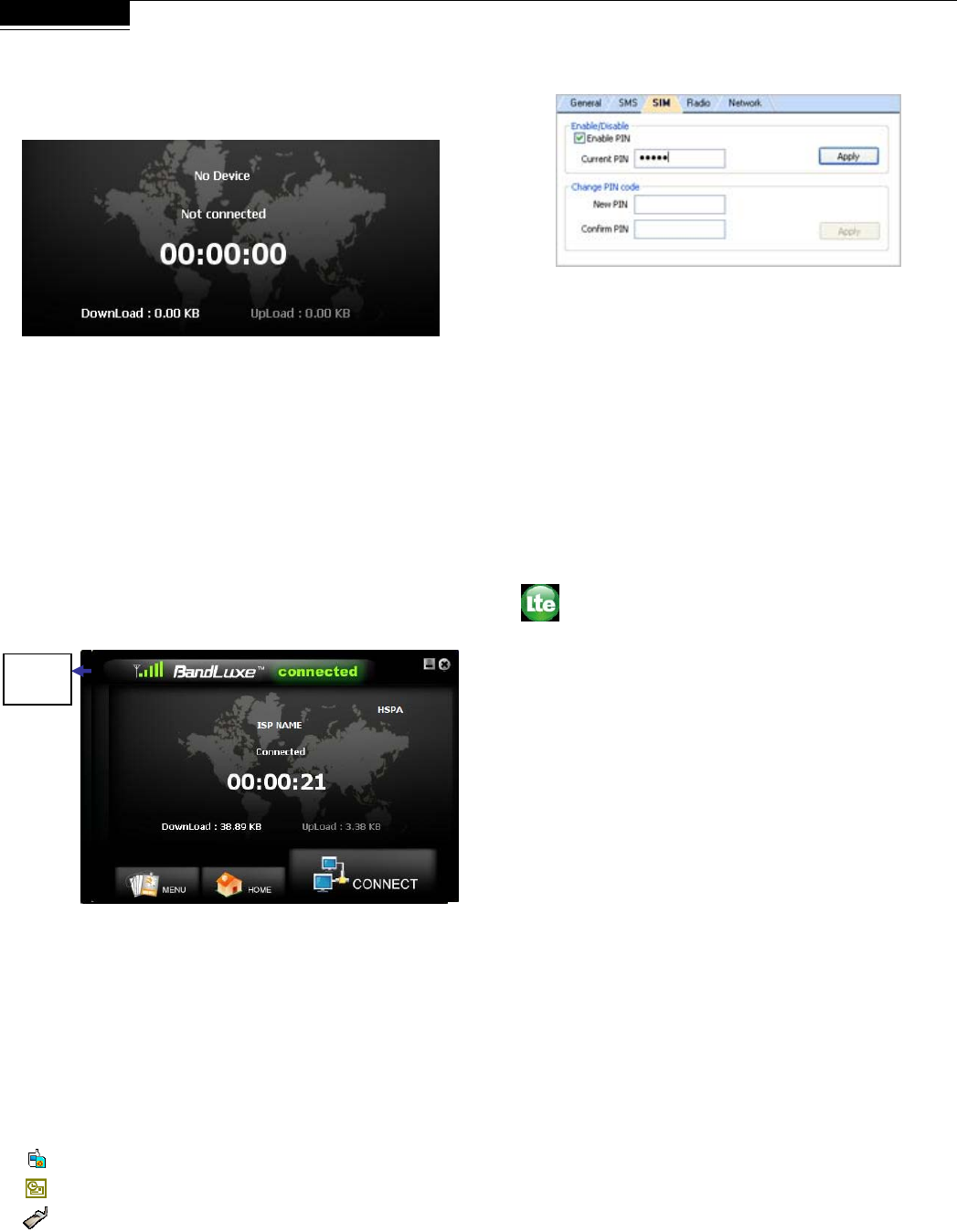
19
C
ha
p
ter
6
Q&A
Q: Why does the Home screen display
No
Device
?
A: Make sure that the C505 is plugged in/inserted correctly. If it is, and
No Device is still displayed, check the LED.
If the LED is not lit, the problem could be:
- The USB port is not activated. Check the Device Manager.
Q: The Home screen is stuck on
Initial SIM Card
,
what should I do?
A: Replug/reconnect the C505 . If this does not work, restart the
computer. If reconnection doesn’t make the C505 activate, check
the SIM card, which may have a poor connection or be locked.
Q: The SIM card is working, so why can’t the
C505 make a connection?
A: Check the profile information; click Menu > Profile. See Chapter 2
for details.
If profile setting is in order, the radio or network setting may need
adjustment. Click Menu > Setting. See Chapter 4 for details. If
Radio and Network settings are in order, please check the signal
strength indicator in the upper left corner of the Connection
Manager.
Q: How do I import contacts into the Connection
Manager?
A: Click Menu > Contacts >
- Import from the SIM Card.
- Import from Outlook.
- Import from the C505 Contacts folder.
Q: Can I prevent others from using my C505 ?
A: Yes. Click Menu > Setting > SIM to enable or change the SIM card
PIN code.
Q: Why do some SMS text symbols display
incorrectly on the receiving phone?
A: This is related to the different decoding schemes used by various
mobile phones. Known problem symbols include:
~ ! @ # $ % ^ & * ( ) _ + ` - = { } | : “ < > ? [ ] \ ; ‘ , . /
Q: The Install Shield Wizard does not
automatically pop-up when I first plug in the
C505 , what should I do?
A: In My Computer, right click on the drive with the Connection
Manager icon and select AutoPlay. This should initiate the Install
Shield Wizard.
BANDLUXE C505 (H:)
Signal
Strength
Indicator
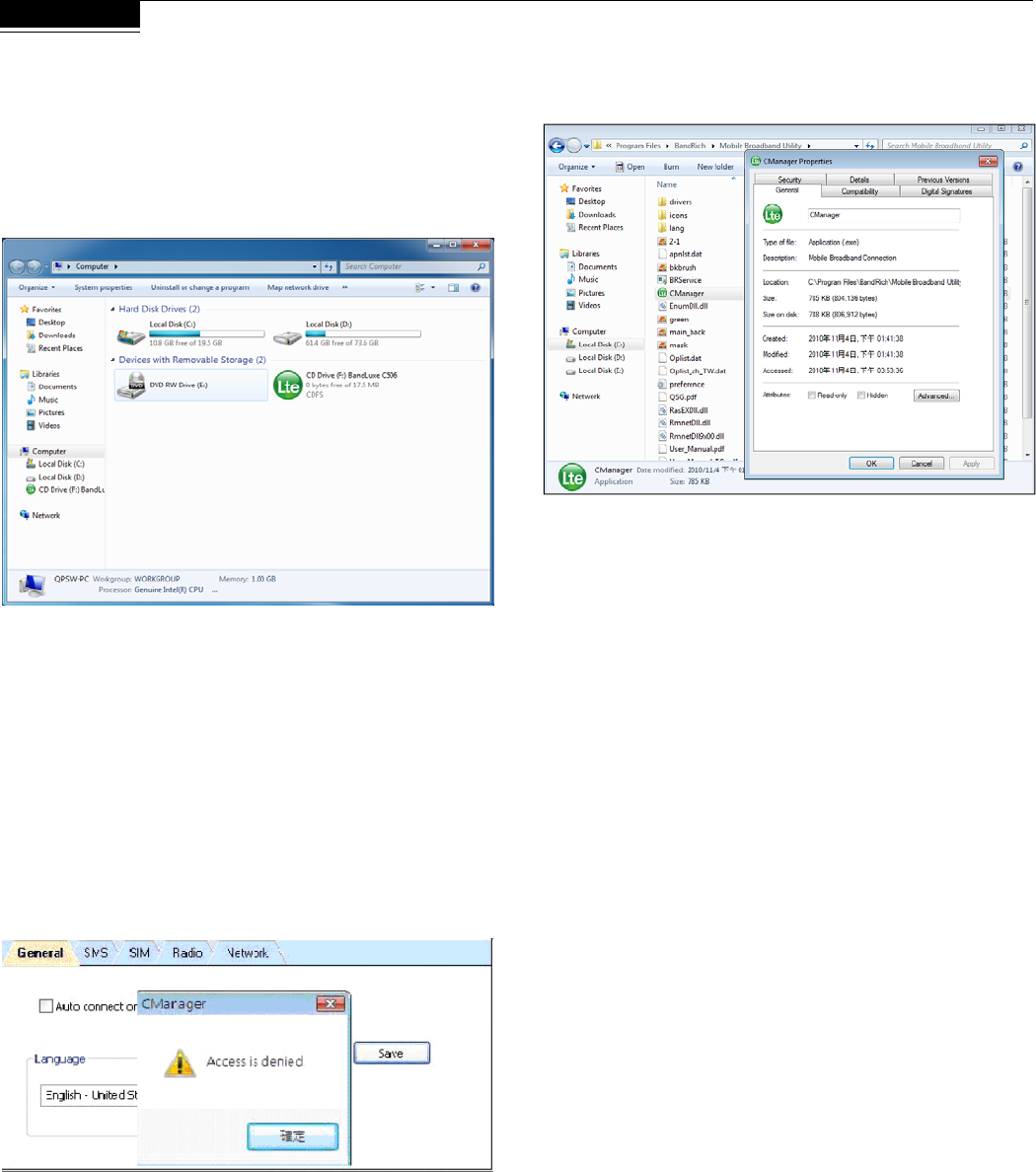
20
C
ha
p
ter
6
Q&A
Q: My computer cannot boot with the C505
connected. Why?
A: As discussed in Chapter 1, during installation the C505 is displayed
in My Computer as a portable storage device.
The computer treats the C505 as if it were a CD drive. Therefore, your
computer may be trying to boot from it, as if it were expecting a Boot
CD. Disconnect the C505 before booting.
Q: How do I view the .pdf Quick Start Guide and
User Manual?
A: Click Start > Programs > BandLuxe > Mobile Broadband Utility
and choose either document. Both files require Adobe Acrobat
6.0+.
Q: The Connection Manager is having troubles
running on Vista. What should I do?
A: You may have a problem with Vista’s user control functions.
1. Open the Connection Manager folder.
2. Right click
CManager.exe > Properties > Compatibility tab.
3. Check
Run this program as an administrator.
4. Click
Apply > OK.
Q: What microSDHCTM card tested in the
BandLuxe C505?
A: BandLuxe C505 have microSDHC reader and support up to 16GB
microSDHC cards. Due to the availability of microSDHC cards, we
recommend SanDisk microSDHC cards.

The BandLuxe C505 Series
Chapter 7
Important Safety
Information and Glossary

22
C
ha
p
ter 7 Important Safety Information and Glossary
Safety Information
Important Notice
Due to the transmission and reception properties of cellular
communications, data can occasionally be lost or delayed. This can be
due to the variation in radio signal strength that results from changes in
the characteristics of the radio transmission path.
Although data loss is rare, the environment where you operate the
C505 may adversely affect communications. Variations in radio signal
strength are referred to as fading. Fading is caused by several different
factors including signal reflection, the ionosphere, and interference
from other radio channels.
BandRich Inc. or its partners will not be held responsible for damages
of any kind resulting from the delays or errors in data transmitted or
received by the BandLuxe C505 or failure of the BandLuxe C505 to
transmit or receive such data.
BandLuxe™ is a registered trademark of BandRich Inc.
Potential Hazards
Do not operate the BandLuxe C505 in an environment that may be
susceptible to radio interference resulting in danger; specifically:
Areas where prohibited by the law.
- Follow any special rules and regulations and obey all signs and
notices. Always turn off the host device and remove the C505 from
the card slot when instructed to do so, or when you suspect that it
may cause interference or danger.
Where explosive atmospheres may be present.
- Do not operate your C505 in any area where a potentially explosive
atmosphere may exist. Sparks in such areas could cause an
explosion or fire resulting in bodily injury or even death. Be aware
and comply with all signs and instructions.
- Users are advised not to operate the C505 while at a refueling point
or service station. Users are reminded to observe restrictions on
the use of radio equipment in fuel depots (fuel storage and
distribution areas), chemical plants or where blasting operations
are in progress.
- Areas with a potentially explosive atmosphere are often but not
always clearly marked. Potential locations can include gas stations,
below deck on boats, chemical transfer or storage facilities,
vehicles using liquefied petroleum gas (such as propane or butane),
areas where the air contains chemicals or particles, such as grain,
dust or metal powders, and any other area where you would
normally be advised to turn off your vehicle engine.
Near Medical and life support equipment.
- Do not operate your C505 in any area where medical equipment,
life support equipment, or near any equipment that may be
susceptible to any form of radio interference. In such areas, the
host communications device must be turned off. The C505 may
transmit signals that could interfere with this equipment.
On an aircraft, either on the ground or airborne.
- In addition to FAA requirements, many airline regulations state that
you must suspend wireless operations before boarding an airplane.
Please ensure that the host device is turned off and your C505 is
removed from the card slot prior to boarding aircraft in order to
comply with these regulations. The C505 can transmit signals that
could interfere with various onboard systems and controls.
While operating a vehicle.
- The driver or mobile network operator of any vehicle should not
operate a wireless data device while in control of a vehicle. Doing
so will detract from the driver or mobile network operator’s control
and operation of that vehicle. In some countries, operating such
communications devices while in control of a vehicle is an offense.

23
C
ha
p
ter 7 Important Safety Information and Glossary
Regulations
CE Marking
This device has been tested to and conforms to the regulatory
requirements of the European Union and has attained CE Marking.
The CE Mark is a conformity marking consisting of the letters “CE”.
The CE Mark applies to products regulated by certain European health,
safety and environmental protection legislation. The CE Mark is
obligatory for products it applies to: the manufacturer affixes the
marking in order to be allowed to sell his product in the European
market.
This product conforms to the essential requirements of the R&TTE
directive 1999/5/EC in order to attain CE Marking. A notified body has
determined that this device has properly demonstrated that the
requirements of the directive have been met and has issued a
favorable certificate of expert opinion. As such the device will bear the
notified body number 0678 after the CE mark.
The CE Marking is not a quality mark. Foremost, it refers to the safety
rather than to the quality of a product. Secondly, CE Marking is
mandatory for the product it applies to, whereas most quality markings
are voluntary.
Marking: The product shall bear the CE mark, the notified body
number(s) as depicted to the right. CE 0560.
15.21 Federal Communications Commission
(FCC) Statement
You are cautioned that changes or modifications not expressly
approved by the part responsible for compliance could void the user’s
authority to operate the equipment.
15.105(b) Federal Communications
Commission (FCC) Statement
This equipment has been tested and found to comply with the limits for
a Class B digital device, pursuant to part 15 of the FCC rules. These
limits are designed to provide reasonable protection against harmful
interference in a residential installation. This equipment generates,
uses and can radiate radio frequency energy and, if not installed and
used in accordance with the instructions, may cause harmful
interference to radio communications. However, there is no guarantee
that interference will not occur in a particular installation. If this
equipment does cause harmful interference to radio or television
reception, which can be determined by turning the equipment off and
on, the user is encouraged to try to correct the interference by one or
more of the following measures:
- Reorient or relocate the receiving antenna.
- Increase the separation between the equipment and receiver.
- Connect the equipment into an outlet on a circuit different from that
to which the receiver is connected.
- Consult the dealer or an experienced radio/TV technician for help.
You are cautioned that changes or modifications not expressly
approved by the party responsible for compliance could void your
authority to operate the equipment.
Operation is subject to the following two
conditions:
1) this device may not cause interference and
2) this device must accept any interference, including interference that
may cause undesired operation of the device.
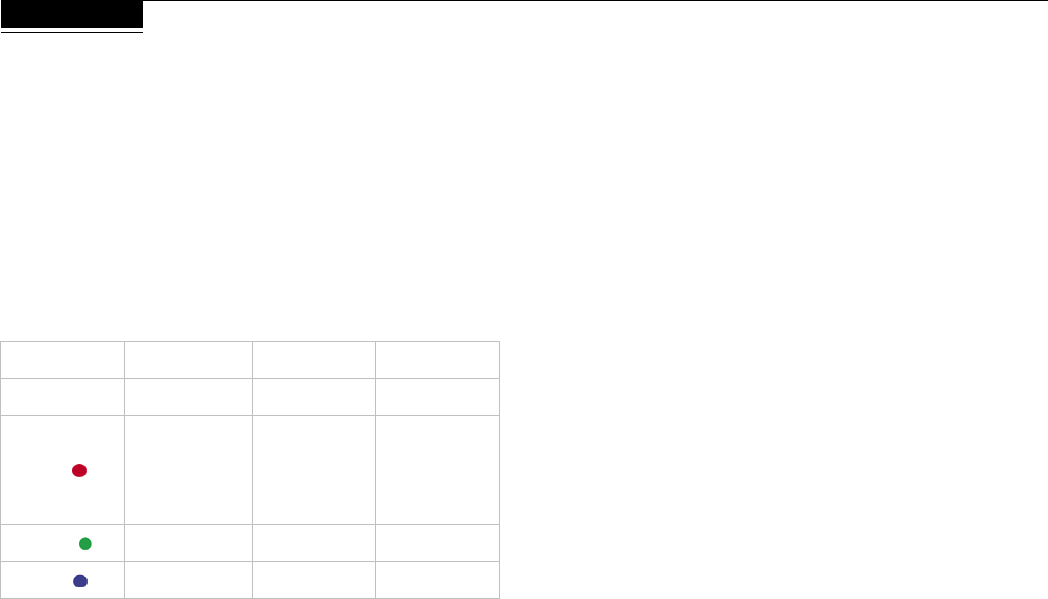
24
C
ha
p
ter 7 Important Safety Information and Glossary
Specifications
System Requirements
Operating System: Windows 7, Windows Vista, Windows XP SP2+,
Web Browser: Internet Explorer 6.0+
LED Indicators
Color Indicator Flashing Solid
Off Not Connected NA NA
Red SIM Card/Service
No coverage/
still searching
Error (SIM card
missing, failed
verification)
Green WCDMA Available Connected
Blue LTE/HSPA+/HSPA NA Connected
Hardware
Dimensions: 77.5 x 27.5 x 14.5 mm Typical (USB retracted)
Weight: 32g
Onboard Memory: 128 MB NAND Flash
UMTS Bands: AWS/850/1900 bands
LTE Band: AWS/700MHz (band17)
GSM Band: 850, 1900MHz
Environment
Operation Temperature 0oC to 45oC (32oF to 112oF)
Storage Temperature -20oC to 65oC (-4oF to 149oF)
Connectivity
Internet: NDIS
Data Speed Downlink: 100 Mbps (Max)
in bps: Uplink: 50 Mbps
IP Settings: APN, DNS, DHCP vs. Static, Radius
Glossary
2G: Second-generation mobile networking technology. Represents a
switchover from analog to digital; most 2G networks use GSM.
3G: Third-generation mobile networking technology that enables
simultaneous transfer of voice and non-voice data; most 3G networks
use WCDMA.
3.5G/ HSPA: A more recent standard of mobile networking technology;
generally uses HSDPA
3.75G/ HSPA: A more recent standard of mobile networking
technology; generally uses HSUPA
4G/LTE: LTE is the next-step of the evolution of UMTS (3G) and
HSDPA (3.5G), now known as 4G.
APN (Access Point Name/Network): Provides GPRS routing
information. Consists of:
Network ID: Identifies the external service requested by a GPRS
user.
Mobile network operator ID: Specifies routing information.
ARFCN (Absolute Radio Frequency Channel Number): The
specific ID numbers for all radio channels used in cellular mobile
communications.
bps (bits per second): How data flow is measured.
DNS (Domain Name System): Helps route network traffic by making
the addressing process more user-friendly.
DHCP (Dynamic Host Configuration Protocol): How devices obtain
IP addresses from a server.
EDGE (Enhanced Data GSM Environment/Enhanced Data for
Global Evolution): Advanced GPRS that delivers multimedia and
other data needing greater bandwidth at up to 237 kbps.
GPRS (General Packet Radio Service): Delivers data in packets at
up to 86 kbps.
GSM (Global System for Mobile Communications): The most
popular cellular network, mostly operates in 850-900 or 1800-1900
MHz; the primary 2G system.
IMEI (International Mobile Equipment Identity): A number unique to
each GSM/UMTS device that can be used block network access by a
stolen mobile device.
IP (Internet Protocol): Routes packets over a network.
HSDPA (High Speed Downlink Packet Access): Advanced WCDMA
that delivers downlink bandwidth intensive data at up to 7.2Mbps;
typically associated with 3.5G.

25
C
ha
p
ter 7 Important Safety Information and Glossary
HSUPA (High Speed Uplink Packet Access): Advanced WCDMA
that delivers uplink bandwidth intensive data at up to 5.76Mbps;
typically associated with 3.75G.
3.75G/HSPA+ (High Speed Packet Access +): This is also known as
HSPA Evolved, is the next step and is more focused on delivering data
service enabling speeds of up to 42Mbps in the downlink and 11Mbps
in the uplink..
LTE(long term evolution): LTE is the next-step of the evolution of
UMTS (3G) and HSDPA (3.5G), now known as 4G. that delivers
downlink bandwidth intensive data at up to 100Mbps and uplink
bandwidth intensive data at up to 100Mbps
Kbps (Kilobits per second): A data flow measure; 1024 bits/second.
LAN (Local Area Network): A data network with limited range but
good bandwidth.
Mbps (Megabits per second): A data flow measure; 1,048,576
bits/second.
NDIS (Network Driver Interface Specification): a Windows device
driver interface that enables a single network interface card to support
multiple network protocols.
PPP (Point-to-Point Protocol): An internet connection method.
PIN (Personal Identity Number): Four to eight digital numbers SIM
card security code; allows access to the carrier’s network.
Rx: Shorthand for Reception.
SIM (Subscriber Identity Module): A small card that contains key
mobile device identification, subscription and contact information.
SMS (Short Messaging Service): Allows text messages of up to 160
characters.
Tx: Shorthand for Transmission.
UMTS: Universal Mobile Telecommunications System is one of
the third-generation (3G) cell phone technologies
WCDMA (Wideband Code Division Multiple Access): Advanced
EDGE that supports 384kbps data flow. Most 3G networks use this
standard; aka UMTS.